Finnish Lapland
region of Finland
Finnish Lapland (Finnish and Sámi: Lappi, Swedish (and Norwegian): Lappland) is the Arctic far north in Finland, strictly defined as the province of the same name, but in practice starting near the Arctic Circle. Most Finnish ski resorts are here, as well as the biggest national parks. Lots of wilderness, much of it quite accessible also for those who are not seasoned hikers.
Temperatures can plunge as low as -50°C (-60°F) in midwinter and the sun is not seen for days on end during the polar night (Finnish: kaamos, Sámi: skábma). By contrast, summer brings out the midnight sun and temperatures can occasionally rise to 30°C. Popular seasons include the time around Easter, when the freezing nights keep skiing conditions good despite strong sunshine in the day, and early autumn, when leaves turn red and yellow and the mosquitos are gone.
Finnish Lapland is a fairly popular destination. According to official figures, in 2023 there were 4.9 million overnight stays.
Regions
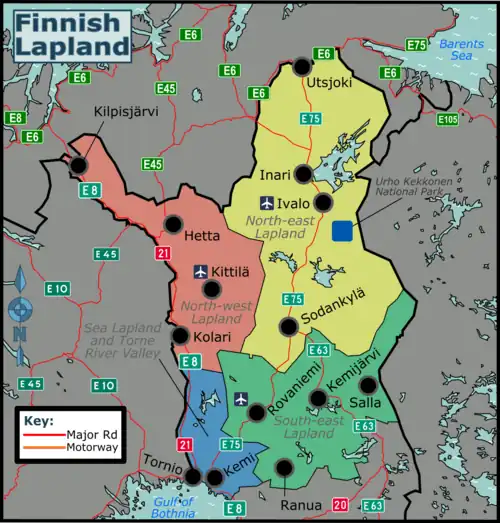
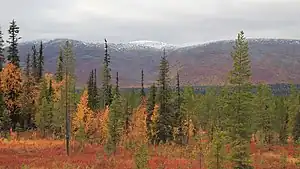
Comprising almost a third of Finland, different parts of Lapland have a somewhat different character.
- South-east Lapland — including Rovaniemi at the Arctic circle. With forests and lakes, the region is landscape-wise a kind of border region between Lapland and inland Finland further south, though the landscape does feature some mountains, hills and ski resorts.
- Sea Lapland and Torne River Valley — Mostly south of the Arctic Circle, much of it not part of the reindeer husbandry area, this is a rather flat part of Lapland with water (the Bothnian Bay and Torne River) and Sweden to the west.
- North-east Lapland — The northernmost part of Finland, and indeed of the European Union, features Sámi culture and landscapes typical to many people's perception of Lapland. Much of the region is covered by national parks and wilderness areas, and here you can find Lake Inari with holy sites of the traditional Sámi religion and a shoreline of over 3000 km.
- North-west Lapland — As the alternative name Fell Lapland reveals, much of the landscape is dominated by fells, in particular in the "arm" where the highest mountains in Finland are. Like the northeast, much of it belongs to the Sámi native region and there are many protected areas. You can experience barren landscapes above the treeline that are unlike anywhere further south in the country. Although much of the region is off the beaten path, in season you will have company on some of the wilderness trails, and two of the most popular ski resort in the country are here.
Cities
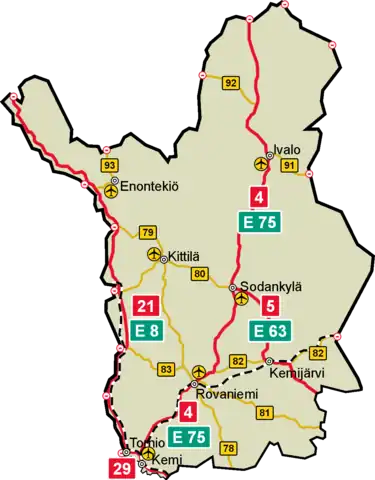
Lapland is divided into twenty municipalities, four of which (Tornio, Kemi, Rovaniemi, and Kemijärvi) are denoted as a city. Some of the other "cities" have just a few hundred inhabitants, if that, but here we go.
- 🌍 Rovaniemi – Entrance to the Lapland for most. The province capital, the main transport hub, a university town, and the only city of any size. At the Arctic Circle with workshops of Santa Claus, where most people go to meet him.
- 🌍 Hetta — administrative centre of Enontekiö; gateway to some northern national parks and wilderness areas
- 🌍 Inari - village with the Sámi parliament and the Sámi museum Siida, by Lake Inari with its labyrinthine archipelagos
- 🌍 Kemi – a bleak paper industry town best known for Arctic icebreaker cruises for tourists and the world's largest snow castle
- 🌍 Kemijärvi - a paper industry town, a terminus of a night train
- 🌍 Kilpisjärvi – alpine village at the border of Finland, Sweden and Norway, near the tallest fells of Finland
- 🌍 Ranua – wildlife park having the only polar bears in Finland
- 🌍 Tornio – a town that together with its Swedish half Haparanda is a prime example of cross-border cooperation
- 🌍 Sodankylä – Midnight Sun Film Festival
- 🌍 Utsjoki – the salmon river Teno, border crossing to Norway
Other destinations
National parks and wilderness areas
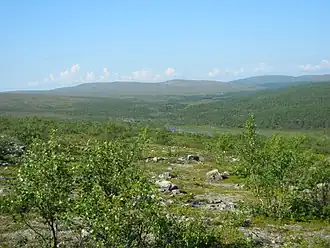
- 🌍 Bothnian Bay National Park – rocky islets, juniper and meadows in an archipelago still affected by the glacial rebound, with bird life and former fishing bases
- 🌍 Kevo Strict Nature Reserve – an impressive canyon with a 64-km hiking trail
- 🌍 Käsivarsi Wilderness Area – this is where the Finland's highest fells are
- 🌍 Lemmenjoki National Park – river valley with riverboats, gold digging grounds, some fells and vast surrounding wilderness
- 🌍 Muotkatunturit Wilderness Area – true wilderness with quite easy terrain, partly above the treeline, with few marked trails and few services
- 🌍 Oulanka National Park on the Salla-Kuusamo border, with the northern end of the Karhunkierros trail
- 🌍 Pallas-Yllästunturi National Park – fell range on the border between Forest-Lapland and Fell-Lapland, protected as one of the first national parks in Finland, good communications and services
- 🌍 Riisitunturi National Park – small but nice national park around the fell Riisitunturi
- 🌍 Urho Kekkonen National Park – national park by Saariselkä and all its services, with vast backcountry, including the home of Joulupukki, Santa Claus himself
Ski resorts
- 🌍 Pyhä – quite large ski resort and a nature lover's destination by the popular Pyhä-Luosto National Park
- 🌍 Levi – The biggest winter sports resort in Finland, popular especially among young people
- 🌍 Luosto – ski and safari resort, home to the only open amethyst mine in Europe
- 🌍 Saariselkä — famous holiday resort in southern Inari. Popular mostly for the older set; a gateway to one of the largest national parks in Europe
- 🌍 Suomu – a small but popular ski resort
- 🌍 Äkäslompolo and Ylläs – two ski resorts by the Ylläs fell
Understand
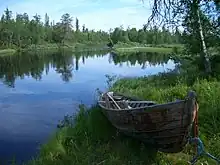
Lapland is the Wild North of Finland. Outside cities wilderness – with half-wild reindeer – is everywhere. Even by the roads the distances between villages are long and villages on the map may be home only to a few families, some even uninhabited part of the year.
Lapland has traditionally been home for the Sámi people, who for centuries have got their living from this barren region, mainly from fishing, hunting and reindeer husbandry. In the northernmost municipalities they are a sizeable minority, within some regions even majority. Most tourist enterprises – especially those not Sámi – from Rovaniemi onward draw on Sámi culture, offering you invented "genuine" rituals etc. Take it for what it is and just enjoy – or avoid such programmes. Genuine Sámi culture is better experienced in community centres, at cultural events and using services of Sámi tourist businesses (which often do not make any notion about their ethnicity). In southern Lapland the original Sámi population integrated with the Finnish and disappeared, but many from the North study or work in Rovaniemi or the southern cities. Rovaniemi, Oulu, and Helsinki have the largest Sámi population in Finland by the number!
There is not too much history to see. At the end of the Second World War, the retreating German troops implemented a scorched Earth policy to punish their Finnish allies for agreeing to peace with the Soviet Union, razing everything in their path. This episode is known as the Lapland War (Finnish: Lapin sota, Sámi: Lappi soahti). The war lasted only from September 1944 to April 1945 but by the time they were done, some 100,000 people had fled, 675 bridges were blown up, all major roads were mined, and the capital Rovaniemi had only 13 houses left standing. However, it might be useful to understand that before this sad episode, locals and the German troops had a rather deep friendship from which the tourist can still find exciting relics.
But then, people don't come to Lapland for the architecture, they come here for the nature (and Santa). While there are no craggy mountains or fjords here, the endless pine forests and the treeless rounded fells (Finnish: tunturi, Sámi: duottar, várri, oaivi, čearru, etc.) poking out between them can also be breathtakingly beautiful. Finns talk about the "Lapland fever" because of so many who have lost their heart to this land forever.
When to go
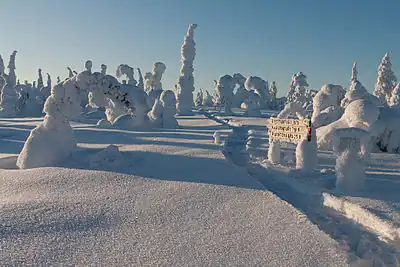
Christmas in Lapland sounds appealing, but this is the time of the polar night; it is dark and it can be very cold (−30°C/−25°F is common, records are around −50°C/−60°F). There are businesses happy to arrange meetings with Joulupukki (Santa Claus) in Rovaniemi and at some other destinations, and snowmobile or husky safaris. With some luck these are arranged in the light of aurora borealis (Finnish: revontulet, Sámi: guovssahasat) visible quite anywhere at these latitudes. Such organised trips are safe, but independent backcountry adventures require adequate skill and experience. If you happen to be in Lapland the first day the sun is seen again in the north, check whether there is a local celebration you could join.
By the end of February both the weather and the light improve, with temperatures on the better side of −10 °C (14 °F) and nearly 12 hours of light a day, although the sun is low and it still feels like perpetual dusk. Most Finns only start to pack in at Easter, when it often is possible to ski in bright sunshine wearing only a T-shirt. It takes quite some time for the accumulated snow (often more than a metre) to melt off, and skiing may be possible as late as May.
In late spring and early summer, the landscape turns muddy as the snow melts, bringing on the curse of the Lapish mosquito and its friends (collectively known as räkkä), and if you think this sounds like a trivial nuisance you have never had to face up to the hordes that inhabit Lapland – do not venture out without industrial-strength insect repellent. Mosquitoes are far less present in the centres of the cities (and above the tree line, especially in sunny weather with some wind) but it is virtually impossible to avoid the bite. The mosquitoes' bites are itchy and their noise is irritating, but they spread no diseases. There is a week or two between the spring floods and the räkkä season, when water levels are manageable and mosquitoes still few, around the end of May and early June. Get advice on local conditions if heading out for the wilderness, as routes and footwear may have to be chosen with some care. During the spring flood, wilderness hikes are only for those truly prepared, as every brook and wadi may have transformed into a river of icy water, partly still covered with snow.
Summer temperatures are usually in the 10–20°C (50–70°F) range, but both freezing nights and +30°C (90°F) days are possible. July is the warmest month.
On the upside, the famous midnight sun is visible in Midsummer in large parts of Lapland (Rovaniemi is at the Arctic Circle, but it can be seen also a tad southward from there) – and middle May through July in Utsjoki. Special events are held to celebrate the equinox and the midnight sun. Many foreigners have difficulty sleeping during these nightless periods, though a simple sleep mask should go a long way.
By late July the mosquitoes start to vanish and they're usually gone by late August. Hiking in the middle of ruska (Sámi: ruški), the colourful time of autumn, is a worthwhile experience. Towards the end of September, you are increasingly likely to get some snowfall, although the first snow usually comes in October.
While ski resorts usually open in November, a reliable natural deep snow cover usually comes quite a bit later; for skiing in the backcountry, you may need to wait until after Christmas or choose routes where the snow cover is sufficient.
Talk
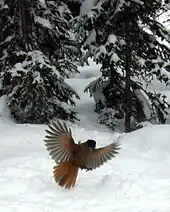
The local language is mostly Finnish. The spoken dialects belong to the Peräpohjola (far-north) subgroup of Finnish western dialects and have certain archaic features that often culminate in the characteristic use of the h-sound. You may encounter some humour based on this. The highly distinctive Torne river valley dialect is known as meänkieli ("Our Language") and has an official minority language status in Sweden.
Three Sámi languages – Northern Sami, Inari Sami, and Skolt Sami – are spoken sparsely to commonly in the northernmost areas. The Sámi languages have an official status in the region designated as the Sámi homeland. Swedish (though official in Finland) is rarely spoken in this area (as adjacent regions in Sweden have traditionally been Finnish speaking), but the closely related Norwegian is often heard in the border region, thanks to the lively shopping Norwegians.
As everywhere in Finland, you will survive very well with English, and it is the main option for those who don't speak Finnish. German and other languages up to Chinese or Japanese might be known at hotels and tourist attractions. Thanks to extensive international tourism, tourist materials are usually available in a wide variety of languages!
Get in
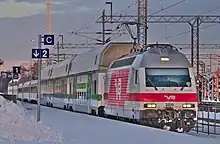
By plane
Flying is the fastest means of reaching much of Lapland, but for most destinations services are sparse and prices often steep. There are commercial airports in Hetta ("Enontekiö"), Ivalo, Kemi, Kittilä and Rovaniemi. Best options for airlines are Finnair and Norwegian. Air Baltic flies to Rovaniemi and Kittilä from Riga. The coaches mostly drive via the airports. In addition to the regular flights, mostly from Helsinki, there are seasonal flights and charter flights from abroad in season.
By train
Most of Lapland is reachable only by bus or car, but even when there is no train service to your destination, using the train for the first leg often makes sense. For some destinations you can buy a combined train/coach-ticket, also otherwise the transfer is usually smooth.
Trains will get you to the towns, most notably to the provincial capital Rovaniemi at the Arctic Circle, or to the northernmost railway station in Kolari. The overnight trains from the south have sleepers and some also take cars. There are two kinds of sleeper trains: the old "blue" pikajuna, mostly used as a complement in peak season, and the modern two-storey ones. The old ones have 3-person cabins and no showers, the new ones 2-person cabins, some of which can be combined for a family, and shared or en-suite showers. There is a cabin for a wheelchair user and an accompanying person in each modern sleeper, and one for those travelling with a pet. During COVID-19, you always get the cabin for yourselves, so filling it up saves in price. The price for a journey from the south to Rovaniemi or Kemijärvi for two people in a sleeper cabin is about €150–300.
If entering from Sweden, there is a gap in the passenger train network before the border at Haparanda/Tornio, but the connecting bus from Luleå is free with Inter Rail and Scanrail. There are again trains from Luleå to Haparanda (terminating some 3.5 km from the Finnish train station in Tornio).
From Russia you can get to Murmansk and continue by bus to Ivalo or get off at Kandalaksha and continue by bus to Rovaniemi. The services might have been suspended in 2022.
By bus
There are coach connections from Helsinki to Rovaniemi (15 hours), which is the hub of most connections. Northern Norway (Troms and Finnmark) has daily connections at least in summer. From Sweden, you will probably come via Haparanda/Tornio, with other options making sense for certain destinations. From Russia, there are bus connections from Murmansk to Ivalo thrice and from Kandalaksha to Rovaniemi twice a week (check!).
Matkahuolto has timetables for most connections, although you may have to try with different place names.
By car
There are good roads to Lapland, but instead of using a day on driving, you might want to get your car on an overnight train and wake up fresh in the morning to enjoy the landscape while driving only the remaining distance – which may certainly be long enough. But you might want to use a few days to see the length of Finland on the E75 (national road 4), or the west coast on E8 (national road 8). The two roads share tarmac on the leg between Oulu and Kemi.
Cars can be loaded on trains in Turku, Helsinki/Pasila and Tampere and unloaded in Oulu, Rovaniemi, Kemijärvi and Kolari – but not all combinations of departure and arrival station are possible, and not all the trains take cars. There are also restrictions on car size (including any add-ons), which may differ between trains. Possible dimensions are height of 1.65/1.84/2.04/2.30/2.60 m, length of 5/10/15 m and width of 2.20 m. A car slot costs about €150. Cars are loaded on the trains in advance, so you are likely going to spend an hour or two in town after having loaded them (but you might be able to get to your cabin early). People who cannot drive aboard themselves, e.g. a single parent with small children, can get this as a service, to be requested in advance.
If you drive from southern Finland, these routes can be recommended:
- To Kemi, Rovaniemi, Kemijärvi, Sodankylä, Ivalo, Inari, Utjoki: E75 or E8 to Kemi, then E75
- To Kolari, Muonio, Kilpisjärvi: E75/E8 to Kemi, then E8 through Tornio
- To Kittilä, Levi: E75, 79 through Rovaniemi
- Alternatively through Kajaani, using road 5 instead of road 4 (E75). This route is more rural and has less traffic.
If you drive through Sweden, these routes can be recommended:
- To Tornio, Kemi: E4 to Tornio, continue to Kemi along E8
- To Rovaniemi, Kemijärvi, Sodankylä, Ivalo: E4 to Tornio, a short leg south along E8, then E75
- To Kolari, Kittilä, Levi: E10, 392, 403 etc. through Pajala
- To Inari, Utsjoki or Kirkenes (Norway): E4 to Tornio, E8, then E75 through Ivalo
- Alternatively through Kolari and route 955, which is 70 km shorter and slightly faster, but the road is of less good quality, more adventurous.
By bicycle
Four EuroVelo cycling routes reach the region (mostly under development as of 2023):
- EV 7 (Middle Europe Route): Malta to Nordkapp along the Swedish coast and via Gällivare, Karesuvanto and Hetta.
- EV 10 (Baltic Sea Route/Hansa circuit): around the Baltic Sea by the coast via Kemi and Tornio.
- EV 11 (East European Route): Athens to Nordkapp) via Helsinki, Kajaani, Oulu, Kemi, Rovaniemi and Karigasniemi
- EV 13 (Iron Curtain Trail): Rezovo to Grense Jakobselv via Kuusamo, Salla, Sodankylä, Inari, Näätämö and Kirkenes
There are not too many cycleways in sparsely inhabited areas like this, but there isn't too much traffic either on most roads. Check route descriptions. You also have to be prepared for the long distances and the climate – although Oulu is one of the Finnish towns with most cyclists.
Get around
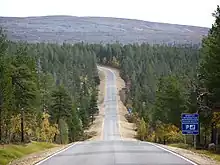
Distances in Finnish Lapland are great and train service extends only to Kemijärvi (80 km northeast Rovaniemi) and Kolari, so the independent traveler will thus have to rely on slightly cheaper but infrequent buses to get around. There is little competition in public transport in Lapland and indeed the voyage from Helsinki to Rovaniemi is easily cheaper than the voyage from Rovaniemi onwards!
By bus
Long distance coaches or minibuses cover most of even the smallest places, often with sparse schedules (typically one or a few services a day along the main roads). They are the cheapest and slowest means of transportation. Although there are bus stops of course, they can also be stopped by hand sign when you happen to meet one as a hiker on a lonely countryside road. Express coaches usually turn into regular ones somewhere north of Rovaniemi. Matkahuolto has timetables for most of these. For some destinations you should look for school buses, postal carriers or shuttle taxis.
The main companies for northern Lapland are Eskelisen Lapinlinjat and Koiviston auto. For smaller places, check also municipal pages (or the destinations guides). Onnibus offers cheaper bus service by a few intercity routes and has cooperation on some other legs ("Onniflex", meaning you find the services also through the Onnibus site, usually with the same price as through Matkahuolto). Generally coach prices are stable; low-cost offers are not something to expect. This also means that you don't have to buy tickets on the net – paying to the driver will usually be at the same price. However, a few connections need to be ordered in advance, as you might be the only passenger.
If you are waiting for a coach at the bus stop, note that the vehicle on the scheduled route may not actually be a bus, but a smaller car like a taxi. A coach ticket will still apply.
By train
The long-distance trains are usable on two routes: from Oulu to Kemi and farther north-east to Tervola, Rovaniemi and Kemijärvi, or northwards via Tornio, Ylitornio and Pello all the way up to Kolari.
By taxi
Taxis are not necessarily connected to any call centres. Ask locally for phone numbers of individual taxi businesses. You don't want to have a taxi drive 100 km to fetch you, if that can be avoided; the fetching distance may show in the price (or you might want to tip generously). Often there is just one or two family businesses serving an area, other taxis may have to drive a long way.
If you use any local businesses, you could ask them about transport. They probably know all taxi drivers, might know the quirks of local public transport, and might be willing to offer a ride themselves.
- Smartphone apps (don't expect them to be usable or sensible everywhere): Valopilkku, 02 Taksi, Menevä, Taxi Booker (iTaksi), Taksi Helsinki
By car
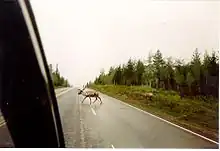
You can reach most places in Lapland by car (yes, there are still villages without road connection!), but traffic even on main roads is sparse and distances are great. Minor roads are sometimes truly minor, even the longest ones. By selecting the shortest route shown on the map, you may not get the fastest route. The roads are at least in moderate condition though – in summer. The northernmost motorway in the world is between Kemi and Tornio, the other highways are undivided two-lane roads, some minor roads are narrow enough that there are signposted meeting places.
Bring emergency supplies in case of a collision or breakdown, especially in winter. Locals will help if they can, but you may be in for a long, very cold wait.
If you want to make a one-way hike, some businesses may offer to drive your car to the destination.
If you are going to rent your car, check availability and prices beforehand. In Rovaniemi and Kittilä there are probably enough businesses, but in the far north you may have to take what is offered, and call to have anything offered.
Roadkill
Stay very alert, particularly at dawn and dusk, for wild animals. Reindeer are a common cause of accidents, while collisions with much larger elk (moose) are rarer but very often lethal. If you hit an animal, you must always inform the locals (or 112), even if the animal seems to be unharmed, as they will in turn inform the owner of the deer, or local hunters. Mark the place so that it can be found. You won't be charged with anything unless you were drunk or speeding.
Unlike moose, which usually runs to the road suddenly and alone, the reindeer hang around peacefully in groups and collisions are usually easy to avoid if slowing down at once when the first reindeer appear in sight (drive carefully, as they may suddenly regroup in front of your car).
Winter driving
Driving in Arctic conditions can be hazardous in winter. Ask about conditions for the minor roads, as winter maintenance may not be what you expected. You will certainly not want to use summer tyres in wintry conditions; use Nordic winter tyres, which are soft enough also at low temperatures.
The most dangerous weather is when the temperature is around freezing, when slippery but near-invisible black ice forms on the roads or the icy surface is wet. Do not venture out before you understand the issues, and make sure the windows are clear from snow and moisture. Locals are trained for those slippery conditions already in the driving school, are you?
Main roads are cleared from loose snow, but you'll drive on packed snow. Some small roads are not maintained in winter at all. Small roads that are cleared may still have issues with a slippery ice slope sideways, as water flowing down a hillside under the snow freezes on the exposed road ("naled", Finnish: paannejää).
Liikenneturva, the Finnish road safety agency, maintains a Difficult driving conditions page in English.
Hitchhiking
Hichhiking is possible and in fact quite popular. Also the locals commonly use Facebook groups for intervillage commuting. However, true hitchhiking can only be recommended during the brief summer season. Traffic is sparse even on the main roads and outside the town you're very, very much on your own. On the other hand the likeliness of getting a lift is quite high once a car passes! Far more likely than in the southern cities. Close to the borders people are usually more likely to drive towards the border than into the inland. Especially, getting a hike from Utsjoki to Inari or from Enentekiö to Kittilä may appear tricky as few have any need to drive south. Always make sure that you are able to survive if the next car won't come. Thanks to the Finnish rescue system, by calling 112 you will eventually be taken to safety. However, it may take hours. Realize the distances, necessity of the mosquito repellent, and make sure that someone always knows where you should be.
By snowmobile
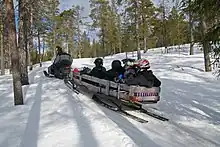
In winter there are some 20,000 km of snowmobile routes and tracks in Finland maintained by municipalities or the forestry administration (Metsähallitus), mostly in Lapland but stretching down to Central Finland and Northern Karelia. The routes often pass by campfire sites, day huts, reservation huts and other infrastructure in the wilderness (but using open wilderness huts for overnight stay is allowed only for those coming by own muscle, you have to pay for beds in reservation huts or other lodgings unless sleeping in tents).
You need the vehicle, suitable gear, helmets, a driving licence (one for cars or motorbikes is enough) for the "routes" or a permit for most "tracks"; "routes" are counted as public roads, the permits count as landowner permission for the specific tracks. The Metsähallitus permit costs €9/3h, €15/day, €30/week, €50/year, the last covering all family (not independent children). In many areas the municipality or tourist businesses maintain their own track network. Snowmobiling along roads or off the specific routes and tracks is not permitted (exceptions for reindeer husbandry etc., which may apply to your tour guide); on frozen water driving is free where not specifically restricted, but mind ice safety! Check route maps and driving rules. Drive gently and follow advice, as it is easy for the less seasoned to make fatal mistakes.
There is an OSM based colour coded route and track map in Finnish; click the leg you are interested in: Moottorikelkkareitti (blue) means snowmobile route, Maksuton moottorikelkkaura (purple) free track, Maksullinen moottorikelkkaura (red) permit-for-pay, Vesistön ylitys (grey) by water, Tuntematon (black) unknown type. Add layers for cafés, wilderness huts etc. depending on needs. Metsähallitus has their own map emphasizing their own tracks (in black, routes and tracks maintained by others in green; many local tracks probably missing).
Snowmobile "safaris" (i.e. tours) are offered by many tourist businesses. The locals, especially those in reindeer husbandry or fishing, use snowmobiles extensively. They were the main invention that allowed people to live in a fixed home while living from reindeer husbandry.
See and do
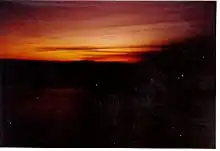

.jpg.webp)
- See also: Hiking in the Nordic countries
Bitterly cold in winter, usually not very warm in summer, and sparsely populated, the main draws for visitors are the desolate yet majestic nature and the unparalleled opportunities for trekking and winter sports. Many businesses know how to help inexperienced foreigners enjoy their stay, e.g. arranging husky or snowmobile safaris, fishing trips, canoeing and northern light watching expeditions.
Finland had its own gold rushes, to Lapland. The heritage is preserved in Lemmenjoki National Park, the nearby Hammastunturi Wilderness Area and the village Tankavaara. In the national park, digging by machine is nowadays forbidden, but gold panners can still be found – as can traces of the activity. In the Hammastunturi area, where gold was found in the 19th century, before roads reached this north, there is an old crown station. Tankavaara has tourist facilities, a mineral exhibition and gold panning championships.
Several national parks can be found in Lapland with marked hiking trails and log cabins open to the public for free. But in contrast to most of Norway, they are only equipped with a stove and wood for heating, no food is provided. For the hardcore trekker there are wilderness areas, with even fewer people and services. To go on your own, basic hiking skills suffice in summer (be sure to know how to use a map and compass). During the spring floods and in winter you should have a guide on any longer trek unless you really know what you are doing.
Lapland is locally known for its fells (tunturi), but these are not any soaring mountains of the alpine kind, but gentle, rounded ones high enough to reach above the treeline (which is much below 1000 m at these latitudes). There are also vast forests and mires in hilly or flat terrain. In the northernmost regions (Utsjoki and Enontekiö) you will find also treeless areas, but real tundra is absent in Finland. The highest mountains are located in the "arm of Finland" in Enontekiö, but because of the location of the road right next to the fells, best views are actually towards Sweden. Still there are magnificent environments available for hikers!
Finland's highest mountain, Halti (1328m) in the farthest north west end of Lapland is not much more than a higher hill of loose rocks, the lower summit of a mountain with its top on the Norwegian side of the border. The surroundings are still very special and a popular, demanding destination. You are nowadays free to cross the border to Norway or Sweden and back where you want (customs formalities, if needed, can probably be taken care of beforehand). An itinerary that takes full advantage of this is the Nordkalottleden hiking trail through the Arctic of the three countries.
For hikers, fishermen and hunters, there is a nice online map of Finland with most trails and huts marked, and a website about most important hiking terrains. Both are maintained by Metsähallitus, an agency that also administers the national parks.
There are of course also cultural events. You might want to attend the international Midnight Sun film festival of Sodankylä or Sámi events such as the St Mary's Day Celebrations.
Northern lights
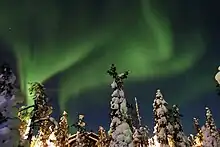
- See also: Northern Lights
Spotting the eerie northern lights (aurora borealis, Finnish: revontulet, Northern Sámi: guovssahas, Skolt Sami: kuuskõõzz) glowing in the winter sky is on the agenda of many visitors. Northern Lapland is one of the best places to observe aurorae, as it has good accessibility, high-quality accommodation and a nearly continental climate with relatively clear skies. The probability of some northern lights is 50–70 % (most often 22:00–24:00) any night with clear skies, and light pollution is quite easy to avoid here – but there are cloudy periods, so do not count on seeing them.
Also in southern Lapland, where probability is about 20 %, you might want to take a walk somewhere out of the light pollution any night with clear skies. If you do not spot northern lights, you will at least get a tremendous view of stars, compared to what you see in most cities.
To have a good chance to see northern lights you should stay at least a few days, preferably a week or more, in the far north in the right season. Probability for aurorae and clear skies varies somewhat from place to place, but all of northern Lapland, about from Sodankylä onwards, should be quite good. More importantly, as you need some luck and persistence, you want to go somewhere where you can enjoy yourself regardless. The ski resort of Saariselkä, easily accessible by plane and with plenty of facilities, is particularly popular among aurora hunters. If you enjoy wilderness and solitude, e.g. areas around Kilpisjärvi and Karigasniemi might be good choices. The village of Nellim is even more remote, being situated on the almost uninhabited eastern side of Lake Inari, where light pollution is at a minimum.
Cloudiness can be quite accurately estimated some hours, chance for major aurorae a few days in advance, so you can know when to go for a tour and when to spend the night in other ways – but as also minor aurorae are well visible in Lapland, you might want to be out any night with clear skies. Intense aurorae occur for 5–15 minutes at a time, so taking a look at the northern sky every now and then over a longer period will increase your chances.
Many businesses arrange northern light watching tours. Usually the tours also have some other theme, such that not seeing the aurorae will not spoil it, but taking care of being in the right place would the aurorae be visible. A week of backcountry skiing will offer even better opportunities unless you spend the best hours in your tent or a hut. A hotel in Kakslauttanen has glass-domed igloo rooms where you can watch northern lights indoors the whole night.
Reindeer and snowmobiles
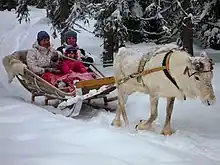
Most of Lapland belongs to the reindeer husbandry area, and nearly all wilderness is in use as reindeer pasture (mostly forested areas in winter and treeless areas in summer). On a week-long hike you are nearly guaranteed to see them in the wild, but at most locations there will also be at least some tourist business having a few tame ones to show, or even to offer rides with (usually by sled). If you make friends with locals you might have a chance to see the round-ups.
Other standard tourist programmes include snowmobile "safaris", i.e. tours, where you usually are allowed to drive your own vehicle (children are probably put in a sled behind your guide), and husky safaris, where you get to try being pulled by dogs. Snowmobiles are probably available for hire if you want to make longer tours on your own.
The tours with dogs, reindeer and snowmobiles can be combined with fishing (ice-fishing in the winter), admiring northern lights or the midnight sun, story-telling and roasting salmon by a campfire, sauna, overnight stay in a goahti and the like. What is available depends on who happens to have a business in the neighbourhood, check what is offered at the business where you intend to be lodging, at least if you do not stay at the bigger resorts. You might want to stay with a family business with the right spirit, especially if you have come to enjoy silence.
Skiing and snowshoeing
.jpg.webp)
The ski resorts do not have the greatest pists, if you compare to the Alps or Norway, but they are good enough for most. On the balance they have lots of accessible wilderness close by, to be experienced by snowmobile or by ski. There are great networks of cross-country skiing tracks around any ski resort, often even a large national park. And tourist businesses eager to offer you other programmes.
For shorter excursions, as along signposted nature trails, you can often use snowshoes. For longer hikes, of more than about a kilometre, skis are much better, easily giving you a jogging speed on any level track. Around the resorts and town centres there are illuminated tracks with space also for "freestyle" skiing. Many businesses offer ten-minutes courses combined with tours in the forest, showing signs of the local wildlife and letting you enjoy the peace and possibly a marvellous view of stars.
For overnight (or multiple-day) hikes on ski you usually want skis that don't let you down even if you leave the tracks. There are ready made tracks for "classic" skiing extending far into the wilderness, but they are not necessarily maintained very soon after snowfall – and you might want to choose routes where no tracks have been made. There are lean-to shelters (Finnish: laavu) and wilderness huts (autiotupa and varaustupa), so overnighting in a tent is seldom necessary, but sleeping bags and other adequate equipment may be needed.
Most tourists want a lot of action in a tight package, so that is what most businesses offer (even if peace and silence, in a suitable packing, often is included). If you really want peace and silence, as on a multi-day skiing tour through the wilderness, you should search for such offers in time – there are guides specializing in that, but they may not be available on short notice.
Father Christmas
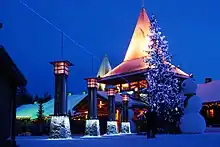
Activities related to Santa Claus, or Joulupukki as the Finns call him, are arranged at least in Rovaniemi and Luosto, probably in most resorts. His main reception and workshop is in Rovaniemi, for tourists' convenience, but most Finns grew up knowing his home is at the fell Korvatunturi. Usually he arrives by foot, having left his sled somewhere farther away, but he can also turn up by a sled pulled by a horse, and possibly reindeer (the flying ones are disappointingly on vacation by themselves when not doing their yearly main job).
Korvatunturi is secluded, in Urho Kekkonen National Park at the Russian border and thus in the border zone, so visiting the fell requires effort and paperwork. Even if you get the permit, it is rare that Joulupukki lets strangers see him there, and his home is not easy to find. There is a hiking trail to Korvatunturinmurusta (2·20 km, the trailhead requiring a long journey along small and even smaller roads), from where you can get a glimpse of the fell, and who knows, he might reward you for the effort by really showing up! At least he will answer mail addressed to Korvatunturi (write to: Joulupukki, FIN-99999 Korvatunturi).
Fishing
Fishing is an important reason for Finns to come to Lapland, and traditionally it was an essential food source up north. Many villages have formed at good fishing sites. There are some great salmon rivers, Teno being the most productive salmon river in all of Europe. Also e.g. trout, greyling and Arctic char are common catches. Catch-and-release fishing is generally not practised.
Angling without reel and without artificial lure, or with a special ice angling rod, is generally included to the right to access – but in any river with salmonoids and in many lakes, there are restrictions in place, and there are also general restrictions on minimum sizes etc. According to Finnish law it is always the fisherman's own responsibility to find out whether there are restrictions on the area.
If you come for the fishing, you probably want to have a reel or use one of the restricted locations. You then need a national fishing permit and a day card for the specific area. Most tourist businesses will gladly fix those for you, explain the regulations, and rent you equipment you need. Notice that in Northern Lapland the locals enjoy privileges that visitors will not have.
For rivers flowing to the Atlantic (the Barents and White Sea, including those flowing into Lake Inari), all your equipment must be disinfected (e.g. by thorough drying) in advance. This is to prevent the Gyrodactylus salaris parasite from spreading from the Baltic Sea basin, as it would be catastrophic in these rivers. Some Atlantic rivers have got it, so disinfection is necessary unless you know you come from a "clean" one. Disinfection applies also to canoe and boots – and don't let birds carry it over with your gutting waste. The easiest way is to let your host do the disinfection as disinfection services are available somewhat everywhere in the areas where the procedure is mandatory. If you cross the border to Norway the law is tighter; you need to possess a written certificate on disinfection even if you wouldn't go ashore.
Hunting
Hunting is popular in Lapland but is usually off-limits for an ordinary visitor. Some tourist businesses take you on tours where you hunt under the close supervision of your guide, which means you do not need own licences. If you have qualifications in your home country you may apply for corresponding licences from Finnish authorities or they might suffice as such, and you might be able to get a permit for some areas. Prepare for bureaucracy.
Work
The ski resorts and many other tourist businesses depend on seasonal workers. As a significant part of the clients are from abroad, being a foreigner is not necessarily a drawback in getting jobs, especially if you know the right languages or cultures – as long as you have or can get a work permit, possibly with help from your to-be employer (reserve enough time for the bureaucracy). Skiing teachers, restaurant and bar personnel, entertainment, child care, what have you. Some jobs require formal qualifications or advanced skills and experience, while for some the right attitude will get you a long way, much more so than for most jobs in Finland.
Common languages to use with clients include English, Russian, German and French, but also some languages from the Far East, where competition from Finns is very limited. Different resorts to some extent concentrate on different groups; try to find an employer who needs your specialities.
Foreign seasonal workers (especially those from outside the EU/EEA) have a weak position and some employers do exploit the fact. Make sure you get a proper employment contract, make notes and keep evidence on any irregularities and don't make yourself reliant on a possibly untrustworthy employer. Overtime, night-time work and any expectations to be available on "free" time should get compensated according to the contract, the trade union agreements and labour law; in many places such issues are handled informally, but then the employer should be equally flexible regarding your wishes and you should be happy about the arrangements. If you think things aren't handled as they should, don't hesitate to ask for outside advice (if you are afraid to do that, or to discuss them with your colleagues, you should definitely find a way out).
Eat
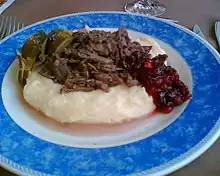
Lapland is the place to sample reindeer (poro) dishes, which are not too common elsewhere in Finland. The traditional way to eat this is as sautéed reindeer aka reindeer hash (poronkäristys), usually eaten with mashed potatoes and lingonberry jam. Also smoked cold cuts and dried reindeer meat are definitely worth trying. In very rare occasions you could face some really interesting reindeer dishes like kampsut made of blood and flour, or koparakeitto, a traditional reindeer hoof soup.
Other Lapland specialties worth looking for are willow ptarmigan and rock ptarmigan (riekko and kiiruna, respectively) and fish such as arctic char (rautu) or lavaret (siika). The delectable cloudberry (hilla or lakka) is one of the most expensive berries in the world. It grows on mires, unripe it is red, ripe it is light orange, containing a lot of vitamin C. In shops you find it most likely as jam (lakkahillo) or syrup. The Crowberry (kaarnikka or variksenmarja) is also a delicious specialty that is rarely encountered any place elsewhere, and usually sold as juice (you will found it abundantly in the fells, but it is small with big seeds, so not as tempting to eat directly).
The Norwegian angelica (väinönputki) is a traditional herb highly appreciated by the Sámi; the angelica is also used e.g. in the French chartreuse and bénédictine liqueurs. It has found its way to some handicraft delicacies. Some related species are very poisonous, so check if you want to look for it yourself.
Rieska is a barley flatbread traditional to the area. The almond-shaped puikula (often as Lapin puikula) potatoes are also a local specialty, although sold and appreciated around the country.
NB! Reindeer meat and cloudberry products are always relatively expensive; especially when buying cold cuts make sure the package says poro somewhere. Seeing similar looking but much cheaper horsemeat and beef cuts sold right next to the reindeer meat is unfortunately common. Cheap cloudberry jams usually contain orange (appelsiini). Check the small-print mandatory ingredients list, to see not only what the producers want to tell.
Drink
Most nightlife is concentrated to Kemi and Rovaniemi, and especially at wintertime: to the skiing resorts!
When hiking in wilderness it is quite safe to drink water directly from rivers. Most hikers use water also from lakes and small clear streams untreated, but you might want to boil that for a few minutes.
Sleep
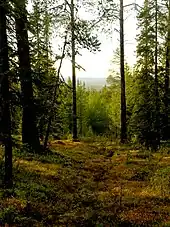
- See also: Hiking in the Nordic countries#Sleep
There are lots of good quality hotels and hostels around Lapland. The scale goes from luxury suites to pole tents where you can sleep next to an open fire. There are also glass igloos for watching northern lights and hotels within snow castles. At least for a longer stay or away from towns you might want to rent a cottage instead. Know what kind of cottage you want, they and their environment and nearby services vary widely. Also check the specific location; a search often suggests cottages that actually are a hundred kilometres from the intended destination.
Most accommodations also have programme services (and may market other available programmes as their own).
Many of the hotels and programme services are owned by big companies and largely staffed with seasonal workers mostly from elsewhere. If you want to use a local business or to interact with local staff, you have to search carefully. Some small businesses are run by people with roots elsewhere who fell in love with Lapland; those may also be interesting options.
At many hiking destinations there are Spartan open wilderness huts available for free, or reservation huts with some equipment for a very moderate price (€15/person/night, check where to get the key). These have firewood, a wood stove for heat and possibly cooking, sometimes a gas stove and pots for cooking, bunk beds with or without mattresses (reservation respectively open huts), an outhouse toilet (use own toilet paper), and some sort of water resource nearby, but hardly anything else (no electricity, no lights). In the open wilderness huts you may stay a night or two, but if the place gets crowded the ones who have had their rest should leave – the ones who come last have an indisputable right to the facilities. Leave the hut in better condition than it was when you arrived. In addition to these there are lean-to shelters and "lapp pole tents", which give some protection from the elements, and "day huts", meant for breaks but usable for overnight stay in emergencies.
According to the Everyman's Right (jokamiehenoikeus) one can set up a "temporary" camp (at least a night or two) nearly anywhere in the forest or on the fell, no matter who owns the land. However, making a fire is allowed only in extreme situations or by permission of landowner. For the campfire sites in national parks, and some wilderness and backcountry areas, there is a general permit. If a wildfire warning is in effect making a fire is forbidden, no matter whether or not you have a permission. In protected areas, such as national parks, there are restrictions also on camping.
Stay safe
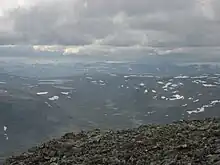
Know your limits. The winter environment is perfectly capable of killing the unwary tourist who gets lost in the fells. The rescue service works well – each year several tourists are rescued and only rarely any serious injury is sustained – but taking your chances is not recommended.
Avalanches are possible in winter. Check with the national parks or ski resorts and make sure you know what you are doing or how to avoid affected areas, if venturing out in wilderness or on non-maintained slopes.
If you plan to travel alone or, for example in your own car, remember that distances are great and getting help for any unexpected situation may take time. Plan accordingly; take extra warm clothes in your car and tell the hotel staff where you are heading and when you expect to come back.
Also mind the hunting season: Natives are usually very keen of hunting, and the start of the season draws most hunters into the wilderness. Potential dangers can be countered by wearing a red cap or some other easily identified garment.
When stopping on the road to enjoy the landscape, don't forget the traffic. Park at a safe spot and keep to the roadside.
Otherwise, there are few serious dangers to your well-being. Tap water and even water of most lakes and creeks is potable (in most places, bottled water contains more harmful compounds than tap water) and foods are almost without exception safe to eat. Crime rates are low and people are helpful and nice. Probability to get robbed or getting any other harm is extremely low. Still avoid getting drunk and noisy at ski resorts (either alone is probably not a big problem safety-wise).
There are rescue helicopters, which should be able to reach you in an hour or two even in the wilderness, weather permitting. There are prepared landing spots by many wilderness huts. If venturing out, you might want to check instructions, otherwise just know your coordinates and some landmarks to make any confusion obvious (the operators have maps to which to compare your description), let the crew decide on where to land, and stay clear of landing aircraft (stones and branches may transform into projectiles). Often a snowmobile or other land vehicles may be enough to reach you.
Hospitals
- Central Hospital of Lapland (Lapin Keskussairaala) is in Rovaniemi taking care of tourists with acute illnesses or accidents. The general emergency clinic is open 24 hr daily (☏ +358 16 328 2140).
- Länsi-Pohja Central Hospital] (Länsi-Pohjan keskussairaala) in Kemi has a 24 hr daily emergency clinic, (☏ +358 40-149-1340).
Go next
- Finnmark – the Norwegian equivalent, still more to the north, bordering the Arctic Ocean.
- Murmansk Oblast — though voyagers of most nationalities need a visa to visit Russia.
- Swedish Lapland in Norrland – with higher mountains.